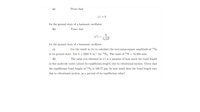Question
Question attached

Transcribed Image Text:a)
Prove that
(x) = 0
for the ground state of a harmonic oscillator.
b)
Prove that
(x²)
2Vuk
for the ground state of a harmonic oscillator.
c)
Use the result in (b) to calculate the root-mean-square amplitude of 14N2
in its ground state. Use k = 2260 N m¬1 for 14N2. The mass of 14N = 14.003 amu.
d)
The value you obtained in (c) is a measure of how much the bond length
in this molecule varies (about its equilibrium length) due to vibrational motion. Given that
the equilibrium bond length of 14N2 is 109.77 pm, by how much does the bond length vary
due to vibrational motion, as a percent of its equilibrium value?
Expert Solution
This question has been solved!
Explore an expertly crafted, step-by-step solution for a thorough understanding of key concepts.
This is a popular solution
Trending nowThis is a popular solution!
Step by stepSolved in 5 steps

Knowledge Booster
Similar questions
- Question 4 .arrow_forwardQuestion 9arrow_forwardProblem 4: Speed deamplifier. In the figure above on the right, block 1 of mass m1 slides along an x-axis on a frictionless floor at speed 4 m/sec.Then it undergoes a one-dimensional elastic collision with stationary block 2 of mass m2 = 2m1. Next, block 2 undergoes a one-dimensional elastic collision with stationary block 3 of mass mz = 4m1. What then is the speed of block 3? Answer: 16 m/sec or 1.78 m/sec.arrow_forward
arrow_back_ios
arrow_forward_ios